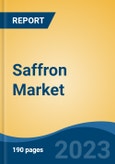Speak directly to the analyst to clarify any post sales queries you may have.
10% Free customizationThis report comes with 10% free customization, enabling you to add data that meets your specific business needs.
Its rising use in wellness and dietary supplements is fueled by awareness of its health-promoting properties, such as antioxidant and anti-inflammatory benefits. The demand for natural and botanical skincare products has also increased saffron’s inclusion in cosmetic formulations. Additionally, improvements in farming techniques and a heightened focus on organic and authentic sourcing are supporting its wider global adoption. These developments are collectively propelling saffron’s demand across diverse sectors.
Key Market Drivers
Rising Demand in the Food and Beverage Industry
The growing use of saffron in the food and beverage industry is a key factor driving market growth. Renowned for its rich color, aroma, and flavor, saffron plays a vital role in a variety of global cuisines, including Middle Eastern, Indian, Mediterranean, and Spanish dishes such as biryani, paella, and saffron-based desserts and beverages. In the United States alone, total spending on food and beverages reached USD 2.6 trillion in 2023, indicating strong support for specialty ingredients like saffron. Western consumers’ increasing appetite for exotic and high-end culinary experiences has further encouraged restaurants and chefs to incorporate saffron into their menus. The popularity of ethnic cuisine, exposure through food media, and trends in home gourmet cooking have all contributed to saffron’s growing presence in both commercial kitchens and household pantries.Key Market Challenges
High Production Costs and Limited Supply
A significant constraint in the saffron market is the high cost of production and the limited geographic scope of cultivation. Saffron threads are hand-harvested from the stigmas of the Crocus sativus flower, requiring about 150,000 flowers to yield one kilogram of product. This labor-intensive process, coupled with the plant’s dependence on specific climate conditions found in select regions like Iran, Kashmir (India), Afghanistan, and Spain, limits production capacity and drives up prices. The fragility of the crop also exposes it to climate-related disruptions, such as drought or excessive rain, further straining supply and affecting price stability. These challenges create entry barriers for new producers and limit scalability, particularly in regions that demand affordable options.Key Market Trends
Product Innovation and Expansion into Personal Care and Cosmetics
The increasing integration of saffron in personal care and cosmetic products is a notable market trend. Known for its anti-aging and brightening properties, saffron is now being formulated into skincare products like serums, creams, and masks. This trend aligns with the rising consumer interest in natural, plant-based beauty solutions. The influence of Ayurveda and traditional wellness practices has further accelerated saffron’s inclusion in holistic skincare routines. Beauty brands are responding by launching premium saffron-based product lines. According to research by Advanced Dermatology, Americans spend an average of USD 897 annually on personal grooming and skincare, underscoring growing demand for effective, naturally derived cosmetic ingredients. As consumers prioritize ingredient transparency and wellness, saffron’s profile in the beauty industry is expected to rise further.Key Market Players
- Esfedan Trading Company
- Tarvand Saffron Co.
- Saffron Business Company
- Safran Global Company S.L.U.
- Mozaffari Saffron L.L.C
- La Casa de los Aromas S.L. (HEA&CO)
- Gohar Ltd.
- Rowhani Saffron Co.
- Royal Saffron Company
- Iran Saffron company
Report Scope:
In this report, the Global Saffron Market has been segmented into the following categories, in addition to the industry trends which have also been detailed below:Saffron Market, By Form:
- Thread
- Powder
- Liquid
Saffron Market, By Application:
- Food
- Medical
- Cosmetics
- Others
Saffron Market, By Distribution Channel:
- Offline
- Online
Saffron Market, By Region:
- North America
- United States
- Canada
- Mexico
- Europe
- France
- United Kingdom
- Italy
- Germany
- Spain
- Asia-Pacific
- China
- Japan
- India
- South Korea
- Indonesia
- South America
- Argentina
- Colombia
- Brazil
- Middle East & Africa
- South Africa
- Saudi Arabia
- UAE
- Turkey
Competitive Landscape
Company Profiles: Detailed analysis of the major companies present in the Global Saffron Market.Available Customizations:
With the given market data, the publisher offers customizations according to a company's specific needs. The following customization options are available for the report.Company Information
- Detailed analysis and profiling of additional market players (up to five).
This product will be delivered within 1-3 business days.
Table of Contents
Companies Mentioned
- Esfedan Trading Company
- Tarvand Saffron Co.
- Saffron Business Company
- Safran Global Company S.L.U.
- Mozaffari Saffron L.L.C
- La Casa de los Aromas S.L. (HEA&CO)
- Gohar Ltd.
- Rowhani Saffron Co.
- Royal Saffron Company
- Iran Saffron company
Table Information
| Report Attribute | Details |
|---|---|
| No. of Pages | 185 |
| Published | June 2025 |
| Forecast Period | 2024 - 2030 |
| Estimated Market Value ( USD | $ 629.76 Million |
| Forecasted Market Value ( USD | $ 941.23 Million |
| Compound Annual Growth Rate | 6.9% |
| Regions Covered | Global |
| No. of Companies Mentioned | 10 |









